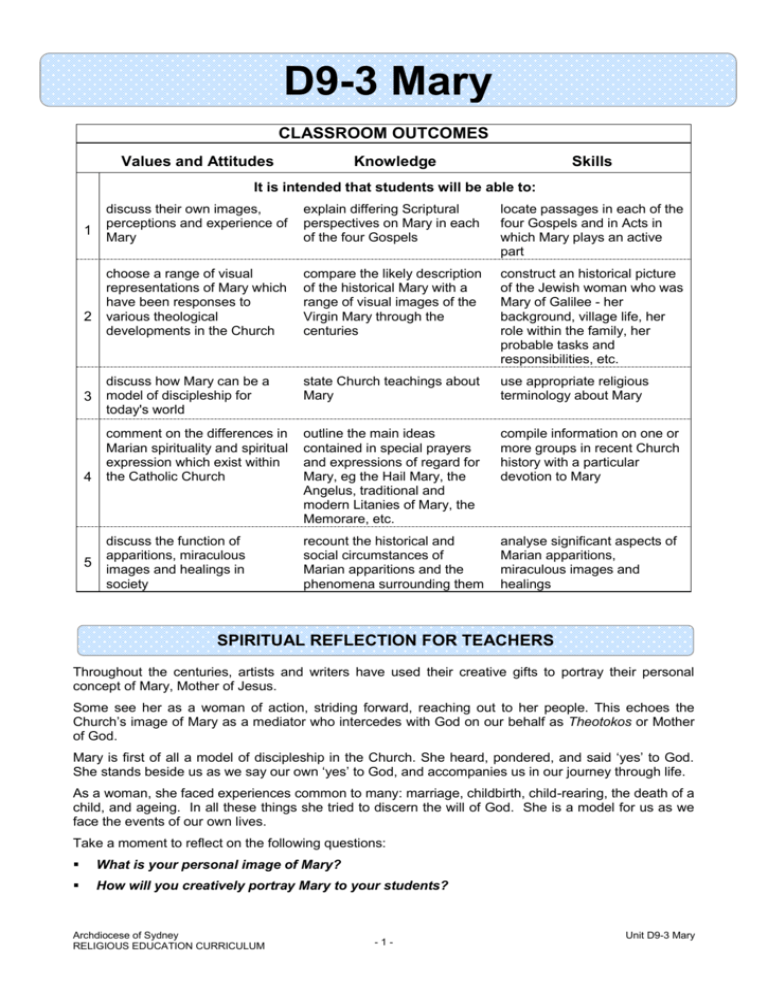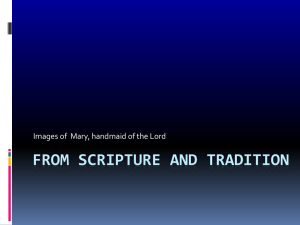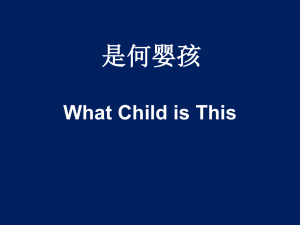Mary D9-3 - Catholic Education Office Sydney
advertisement

D9-3 Mary CLASSROOM OUTCOMES Values and Attitudes Knowledge Skills It is intended that students will be able to: 1 2 3 4 5 discuss their own images, perceptions and experience of Mary explain differing Scriptural perspectives on Mary in each of the four Gospels locate passages in each of the four Gospels and in Acts in which Mary plays an active part choose a range of visual representations of Mary which have been responses to various theological developments in the Church compare the likely description of the historical Mary with a range of visual images of the Virgin Mary through the centuries construct an historical picture of the Jewish woman who was Mary of Galilee - her background, village life, her role within the family, her probable tasks and responsibilities, etc. discuss how Mary can be a model of discipleship for today's world state Church teachings about Mary use appropriate religious terminology about Mary comment on the differences in Marian spirituality and spiritual expression which exist within the Catholic Church outline the main ideas contained in special prayers and expressions of regard for Mary, eg the Hail Mary, the Angelus, traditional and modern Litanies of Mary, the Memorare, etc. compile information on one or more groups in recent Church history with a particular devotion to Mary discuss the function of apparitions, miraculous images and healings in society recount the historical and social circumstances of Marian apparitions and the phenomena surrounding them analyse significant aspects of Marian apparitions, miraculous images and healings SPIRITUAL REFLECTION FOR TEACHERS Throughout the centuries, artists and writers have used their creative gifts to portray their personal concept of Mary, Mother of Jesus. Some see her as a woman of action, striding forward, reaching out to her people. This echoes the Church’s image of Mary as a mediator who intercedes with God on our behalf as Theotokos or Mother of God. Mary is first of all a model of discipleship in the Church. She heard, pondered, and said ‘yes’ to God. She stands beside us as we say our own ‘yes’ to God, and accompanies us in our journey through life. As a woman, she faced experiences common to many: marriage, childbirth, child-rearing, the death of a child, and ageing. In all these things she tried to discern the will of God. She is a model for us as we face the events of our own lives. Take a moment to reflect on the following questions: What is your personal image of Mary? How will you creatively portray Mary to your students? Archdiocese of Sydney RELIGIOUS EDUCATION CURRICULUM -1- Unit D9-3 Mary LINKS WITH STUDENTS’ LIFE EXPERIENCE In the Church today, there has been a tendency to create prayers which celebrate Mary’s womanhood as a link with the life experience of modern men and women. These would make excellent starting points for development of the students’ prayers. At the same time, many students come from cultures which have a strong traditional devotion to Mary. This devotion is often a defining element in cultural identity among migrant groups. As such, it forms an important part of their religious expression; it can provide a rich resource for projects, and be a teaching resource for the classroom. THE CHURCH’S TEACHING AND LIVED TRADITION The Church honours Mary as Blessed Virgin Mary, mother of God. The Council of Ephesus in 431CE declared that Mary is theotokos (Godbearer). All Marian teaching is ultimately Christological: "While honouring Christ's Mother, these devotions cause her Son to be rightly known, loved, and glorified, and all His comments observed" Dogmatic Constitution on the Church, n66. Vatican II also gave an ecclesial (Church) context to Mary. Contemporary thinking about Mary focuses on her as a model disciple in hearing and doing God's word. This enables people today to connect with Mary's experience, and gives a wide ecclesial context to teachings about Mary. Mary as Virgin Mother also has an ecclesial dimension. Like Mary, the Church's mission is to bring Christ to birth in people's lives. The dogma of the Immaculate Conception states that Mary was conceived and born without original sin or the inclination to sin which is part of humanity. It can also be seen as a symbol for the whole Church: that "Mary was full of grace" in her beginnings gives followers of Christ confidence that grace is more 'original' than sin. Like Mary, the Church too is destined for glory, by the power of God to transform human existence. CATECHISM OF THE CATHOLIC CHURCH In preparation for the teaching of this module the following references are recommended: Part One, Section Two: The Profession of the Christian Faith 484 – 511 721 – 726 763 – 775 Conceived by the Power of the Holy Spirit and born of the Virgin Mary Mary and the Holy Spirit Mary, Mother of Christ and the Church Part Four, Section One: Prayer in the Christian Life 2617 – 2619 Mary’s Prayer 487 What the Catholic faith believes about Mary is based on what it believes about Christ, and what it teaches about Mary illumines in turn its faith in Christ. 723 In Mary, the Holy Spirit fulfills the plan of the Father’s loving goodness. With and through the Holy Spirit, the Virgin conceives and gives birth to the Son of God. By the Holy Spirit’s power and her faith, her virginity became uniquely fruitful. Archdiocese of Sydney RELIGIOUS EDUCATION CURRICULUM -2- Unit D9-3 Mary SCRIPTURE: BACKGROUND INFORMATION Mark 3:21, 31-35, kinship group and discipleship; 6:3, the family of Jesus Luke 1:26-56, annunciation; 2:1-21, birth narrative; 41-52, the 12-year-old Jesus in the Temple; 8:19-21, kinship group and discipleship; the burial of Jesus, at the tomb Matthew 1:18-25, birth narrative John 2:1-12, the marriage at Cana; 19:25-27, Mary at the crucifixion Acts 1:14, Mary in the early Christian community. Luke 1:26-56 The Annunciation In the gospel of Matthew the announcement of Jesus’ impending birth is made to Joseph by an angel in a dream. The account focuses on Joseph, and seems to be from his point of view. But in Luke’s gospel the spotlight is on Mary, who is much more involved than Joseph. Thus the two different accounts of the annunciation of Jesus present different insights. The writer of Luke’s gospel presents Mary as a young girl just betrothed, thus aged about 12 or 13 years. She is presented as disturbed, even afraid of the experience she is having. Nevertheless, she has enough confidence to wonder within herself what it all means. The text suggests that, like us, Mary had to reflect on the events of her life to understand them. Most of the text is about the child she will conceive. Only at the beginning and the end of the annunciation do we have some insight into Mary’s reaction. The very last verse indicates that she is willing to be part of the event even if she does not totally understand it. She says – Yes! Let it happen to me. All of this is in keeping with the theme of the gospel of Luke: that God’s abundance is available to the least expected. A virgin from the obscure town of Nazareth will conceive and bear a son who will be great. Luke 2:1-21 The Birth Narrative There are two narratives describing the birth of Jesus, one in Matthew’s gospel and one in Luke’s. We tend to run them together as one complete story, which somewhat defeats the themes and emphases of the two different writers. Luke’s birth story of Jesus has Mary and Joseph travelling from Nazareth to Bethlehem to register in a census decreed by the Emperor, Caesar Augustus (30 BC - 14 AD). Matthew makes no mention of this and has them already living in Bethlehem, not Nazareth. Mary is still only Joseph’s betrothed in both versions but she is pregnant. The writer of Luke’s gospel is concerned for the marginalized, so the news of Jesus’ birth is first told to shepherds, who were low on the social ladder. Mary is shown pondering all that is happening – trying to understand what it is all about. Jesus is circumcised: Luke emphasizes that Mary, Joseph and Jesus are Torah-true Jews fulfilling the requirements of the Law. John 2:1-12 The Marriage at Cana John’s gospel has many levels of meaning. In this gospel, Jesus is always in control of the situation; this is so even when he dies on the cross. Mary appears several times, but the stories are really about Jesus, and in fact she is never mentioned by name, but is called ‘the mother of Jesus’. Nevertheless, we see a confident woman, sure of her own respected status as a mother. At the marriage feast, Mary simply points out the need for more wine to Jesus (wine was a preferred drink, since the water could not always be trusted). She asks for nothing, and Jesus seems to reject her implied suggestion. But Mary appears to remain confident that he can remedy the situation. The words she speaks ‘Do whatever he tells you’ are a quote from Genesis 41:55, where Pharaoh instructs the hungry people to do what Joseph tells them, with the result that food is provided. Archdiocese of Sydney RELIGIOUS EDUCATION CURRICULUM -3- Unit D9-3 Mary SYLLABUS OUTCOMES respect Mary’s role in the life of the Church outline the development of traditions and prayers relating to Mary analyse changing patterns of spiritual, liturgical and artistic expressions relating to Mary Classroom Outcomes It is intended that students will be able to: V discuss their own images, perceptions and experience of Mary K explain differing Scriptural perspectives on Mary in each of the four Gospels S locate passages in each of the four Gospels and in Acts in which Mary plays an active part Essential Reading for Teachers Scripture is an important basis for our understanding of It is intended that students will be able to: V K S choose a range of visual representations of Mary which have been responses to various theological developments in the Church Mary. In Mark there are only passing reference to Mary; her presence provides Jesus with a context for expanding his followers’ understanding of discipleship. In Luke, she is a prophet who announces the coming reign of God. She is shown as a model of all the things a follower of Jesus ought to be. Luke’s Mary is a representation of the way the early Christian community came to cherish and venerate Mary, and to develop a theological perspective on her story. In Matthew, the emphasis in the birth narrative is on Joseph’s experience rather than Mary’s. Mary is seen as being in a vulnerable position; her pregnancy may bring her family into dishonour. In John, Mary, referred to as ‘The Woman’, is presented in two stories, the marriage at Cana and the crucifixion narrative. In the first, she is the means by which Jesus commences his ministry: Mary propels Jesus forward into his future. The bond between mother and son in Jewish society has always been strong: John captures the depth of familial relationships in the second of his stories involving Mary, at the base of the cross. In the Acts of the Apostles, Mary is presented (1) as a member of the early Christian community and (2) as devoting herself to constant prayer. This corresponds to the Jewish ideal of holiness, centred in life: in God and in humanity. Mary is presented as being focused on both God and her community. Throughout the centuries, artistic images of Mary changed in accordance with the needs of society and the Church at the time. Early representations of Mary showed her holding Jesus as a small adult: this was in response to controversies in the early Church about the nature of Jesus - whether he was truly human. compare the likely description of the historical Mary with a range of visual images of the Virgin Mary through the centuries Many depictions of Mary in modern Latin America construct an historical picture of the Jewish woman who was Mary of Galilee - her background, village life, her role within the family, her probable tasks and responsibilities, etc. Teachers could reflect on the messages and symbols in emphasise her peasant origins, with a life similar to the poor and oppressed of those countries. She is seen as a figure of liberation, supporting the Catholic option for the poor. images of Mary, eg body language: what qualities does it express, and what does this say about the current image of ideal womanhood? Examine the symbols used in pictures of Mary (historical and modern), and explore their significance. Archdiocese of Sydney RELIGIOUS EDUCATION CURRICULUM -4- Unit D9-3 Mary LINKS WITH A SENSE OF THE SACRED This module offers the opportunity for students to examine the example of Christian living given by Mary, the Mother of Jesus. Her life offers students a model of discipleship and womanhood in the way she responds faithfully to the message of the Gospel. KLAs can support this by emphasising women who mirror Mary’s response to God in their commitment to building the Kingdom in their particular life situations. Suggested Assessment Teacher Assessment Suggested Teaching/ Learning Strategies Initiate a discussion with students about the images and perceptions they have of Mary. Develop a character profile for Mary that highlights key characteristics of Mary including her personality, qualities, and appearance. Students provide reasons for these personal perceptions. As these images and perceptions are collaboratively brainstormed, students record the different impressions proposed by their group. Group work: Students present key elements of the Gospel portraits outlined in the Essential Reading for Teachers. Divide the class into small groups. Groups locate and read the following references from the Scripture passages they have been allocated: Matthew 1:16-25, 2:11-23, 12:46-50, 13:55-57, 28:1-10 Mark: 3:21, 3:31-35, 6:1-6 Luke: 1:26-56, 2:1-52, 8:19-21, 23:55-56, 24:1-11 John 2:1-12, 19:25-27 Acts 1:14, 2:1-4 Groups prepare a poster that addresses the following: - How is Mary is portrayed in the allocated passages? - What events was she involved in? - How do the passages add to our understanding of Mary? Each group presents their poster to the class justifying the conclusion they have reached. When all presentations are complete, students develop an individual summary of learnings from this activity. Observation of contributions to the collaborative brainstorming activity. Peer Assessment Group presentations on the insights provided in the Scripture passages. Teacher/Peer Assessment Use simple marking criteria to assess the posters produced by groups on the portrayal of Mary in the New Testament. A B C Portrayal of Mary Description & analysis of events Mary is involved in Understandings gained Teacher/Peer Assessment Marking of presentations to class of research. Visual Representations of Mary – see p9 of this unit for full details. Students locate 5 contrasting images of Mary. They use these images to complete the sections of the summary table. Students are encouraged to explain the particular cultural or theological influences in each image. In pairs, students develop a historical profile of the role of Teacher Assessment Marking of historical profiles of the role of women in Jewish society. Peer Assessment Groups exchange design brief and comment on the image and its rational. Archdiocese of Sydney RELIGIOUS EDUCATION CURRICULUM women in Jewish society, their legal and religious status and elements of daily life that would have been common for women in the time of Mary, KWL p214. Group Work: Imagine that a new church has been built in the parish, dedicated to Mary. Your brief is to design a piece of artwork for the church. This could be a statue, painting, mural or stained glass window. There are two components to this task: - Supply a draft of what the image would look like. - Write an explanation of why this image was chosen to represent Mary as she is presented in Scripture and the Tradition of the Church. -5- Unit D9-3 Mary Classroom Outcomes It is intended that students will be able to: V discuss how Mary can be a model of discipleship for today's world K state Church teachings about Mary S use appropriate religious terminology about Mary Essential Reading for Teachers It is intended that students will be able to: V comment on the differences K S in Marian spirituality and spiritual expression which exist within the Catholic Church outline the main ideas contained in special prayers and expressions of regard for Mary, eg the Hail Mary, the Angelus, traditional and modern Litanies of Mary, the Memorare, etc. compile information on one or more groups in recent Church history with a particular devotion to Mary It is intended that students will be able to: V discuss the function of apparitions, miraculous images and healings in society K recount the historical and social circumstances of Marian apparitions and the phenomena surrounding them S analyse significant aspects of Marian apparitions, miraculous images and healings Archdiocese of Sydney RELIGIOUS EDUCATION CURRICULUM The Church honours Mary as Blessed Virgin Mary, mother of God. The Council of Ephesus in 431CE declared that Mary is theotokos (God-bearer). All Marian teaching is ultimately Christological: "While honouring Christ's Mother, these devotions cause her Son to be rightly known, loved, and glorified, and all His comments observed" Dogmatic Constitution on the Church, n66. Vatican II also gave an ecclesial (Church) context to Mary. Contemporary thinking about Mary focuses on her as a model disciple in hearing and doing God's word. This enables people today to connect with Mary's experience, and gives a wide ecclesial context to teachings about Mary. The dogma of the Immaculate Conception states that Mary was conceived and born without original sin or the inclination to sin which is part of humanity. It can also be seen as a symbol for the whole Church: that "Mary was full of grace" in her beginnings gives followers of Christ confidence that grace is more 'original' than sin. Mary as Virgin Mother also has an ecclesial dimension. Like Mary, the Church's mission is to bring Christ to birth in people's lives. The Assumption of Mary into heaven also discloses the Church's destiny for glory by the power of God to transform human existence. In liturgy and traditional prayers we always pray through Mary to God, and never to Mary; to pray only to Mary would be to attribute divine power to her. The main feast days of Mary are the Immaculate Conception (December 8); Mary, Mother of God (January 1); the Annunciation (March 25); the Birthday of Mary (September 8); Our Lady Help of Christians (May 24); the Assumption (August 15). Mary has been celebrated in devotions such as the Rosary and the Litany. She is the patroness of many countries, including Australia, (Our Lady Help of Christians). She has been honoured in hymns, paintings, sculpture, and literature. The titles of Mary indicate hopes and expectations in prayers to Mary. The traditional Litany of Mary promotes particular virtues as ideal for womanhood. A comparison can be drawn by examining a modern litany to Mary. The Seven Sorrows of Mary have touchpoints with tangible human experiences, shared by many: the prophecy of Simeon (hope/anxiety about the future); the flight into Egypt (the plight of refugees); loss in the Temple (making the transition from childhood to adulthood); meeting on the way to the cross, crucifixion, taking down from the cross, burial, (suffering, death and grieving as a universal experience). Marian apparitions, miraculous images and healings have played an important part in the popular expression of religion for many centuries, and they continue to be significant for many Catholics today. It is important that students be able to understand the difference between appropriate devotion and excesses of devotion. The former (appropriate devotion) has always been endorsed by the Church, with Mary’s status in prayer as an intercessor with her Son, or again with the titles of honour which surround Mary as mother of Jesus. This honour is based in Scripture ‘all generations shall call me blessed’, Luke 1:48. The latter (excess of devotion) is not supported by the Church. The Vatican II document Lumen Gentium specifically warns against ‘vain credulity’ and urges us to refrain from ‘false exaggeration’ in our devotion to Mary (Lumen Gentium 8:IV, The Cult of the Blessed Virgin in the Church). The Church’s position on acknowledgment of apparitions has always been cautious. -6- Unit D9-3 Mary Suggested Assessment Teacher Assessment Suggested Teaching/ Learning Strategies Teacher observes student’s contribution to discussion of qualities of a disciple. Teacher questions students about summative written statements of key Church teaching about Mary. Testing of understanding of key Marian terminology through completion and peer marking of proposal for word processing document. Teacher Assessment Observation of student participation in discussion. Questioning of students to judge their grasp of the significance of the doctrines stressed in the various Marian prayers. Marking of Rosary explanation. Marking of quiz on the Seven Sorrows of Mary. Peer Assessment Peer marking of pamphlet activity. Peer Assessment Students in groups read the reports of apparitions and assess the clarity of the newspaper reports, using a simple marking scheme. Teacher Assessment Teacher inquiry via questioning of students to assess completion of KWL p235, Apparitions, Q1 & 2. Archdiocese of Sydney RELIGIOUS EDUCATION CURRICULUM Students define the term ‘disciple’. Develop a list of the qualities of a disciple of Jesus. Review KWL p217ff. List examples from Scripture to show how Mary is an example of discipleship for all Christian people. KWL p223, Church teachings about Mary. Research and develop summative statements about key Church teachings on Mary. These should include an exposition of Catholic beliefs about the Annunciation, Mary as the Virgin Mother of God, The Immaculate Conception, the Assumption and Mary’s role as Mother of the Church. Using a variety of Catholic reference material, develop a glossary of Marian terms such as: Immaculate Conception, Assumption, Theotokosis, ecclesial, dogma, original sin, grace, intercession. This could be a word processing document that is hot-linked to an online dictionary of Religion and/or Catechism. Read John 19:25-35. Students visualise the scene, and describe it in writing. Initiate a discussion on the purpose of Marian prayer, in particular Mary’s role as intercessor, KWL p217. Students develop a statement about the difference between Marian prayer and prayer directed to God. In pairs students are allocated one of the feast days of Mary, KWL p225, to complete the accompanying pamphlet activity. Analyse the main doctrines contained in the Hail Mary, KWL p226. Commence each lesson with a different Marian prayer, eg Angelus, Litanies of Mary, Memorare. At the conclusion of the Prayer, discuss in groups the main doctrines of the prayer. The Rosary: material that outlines the history, Mysteries and traditional importance of the Rosary, KWL p226. Completion of this activity is essential to the Celebration: Prayer and Liturgy section on p8. Research/Brainstorm some common names/litanies for Mary. Discuss the significance of their existence as an expression of veneration by Christians. Seven Sorrows of Mary: Essential Reading. Provide students with notes on the Seven Sorrows of Mary. Students develop a mind map that links each one with common human experiences. Imagine you have travelled back in time to develop a newspaper report that details claims of a Marian apparition. Use KWL p229 and other sources to collate information about an apparition at either Guadalupe, La’Vang, Lourdes or Fatima. You are to imagine that the Church has made no official statement about the authenticity of the apparition, and provide details in your report of the process that the Church adheres to when investigating the authenticity of apparitions. Your report should include a description of the events involved in the apparition, a list of the date and names of key people involved in the apparition, Mary’s message to the visionaries and other key pieces of information. KWL p235, Apparitions, Q1 & 2. -7- Unit D9-3 Mary CELEBRATION: PRAYER AND LITURGY The variety of prayers which address Mary might be used as a starting point for development of a creative liturgy. Symbols and artistic images of Mary which are relevant to the modern world might be developed, explained and used as a basis for prayer. Hymns to Mary from a variety of time periods might be listened to or learnt; mention might be made of the hymns which were part of Mary’s Jewish experience – the Psalms, and the Magnificat. Suggested Celebration based on Luke 1:46-55 In preparing for this prayer service, stress that the Church teaches us that our prayer is not directed to Mary. Rather, we ask Mary to pray for us in her role as mediatrix and intercessor. Develop an appropriate prayer space using images and symbols. Images that have been created by students during this unit could be incorporated into the space. Invite students to bring Rosary Beads to use as part of this prayer service. Leader: In his message to the Church in Oceania in 2001, Pope John Paul II reminded us of the deep devotion to Mary that has always been a feature of faith in our region. Mary continues to join with those who pray to her son, Jesus. In her we find an ear that always listens, a heart that always welcomes and a prayer that never fails. As we commence this time of prayer, we ask Mary to be with us as we place our own personal needs before God. (Pause) Hymn: Chosen to suit the class. Leader: The Word: Leader: We are gathered to listen to Mary’s story and seek her protection in our lives. Despite her age and the enormous task she was asked to undertake, she accepted the challenge of God’s call. We pray that in our lives we will be able to show this same strength of character as we strive to live by the teachings of her son. Luke 1:46-55 is proclaimed by a well-prepared reader. As we continue to reflect on this Scripture we will pray together the First Joyful Mystery of the Rosary, the Annunciation of the birth of Jesus. Mary was surprised and had great concerns about the implications that this event would have for her life. Despite this she did not run away but accepted the role that she was asked to fulfil. While none of us will face such a task, as Christians we are all asked to live as Mary did by being people of justice, compassion and peace. Think about the relationships and situations in your life that are challenging for you at this time and pray for the strength to respond in selflessness and love as Mary did. Pray together the decade of the Rosary. Announce the Mystery, say one Our Father, ten Hail Marys, one Glory Be and then, ‘O my Jesus, forgive us our sins, and save us. Bring all souls to heaven, especially those who most need your mercy.’ Leader: Students: We pray together this prayer of blessing that we will encourage each other to respond to God in our lives as Mary did in hers. Loving God you daily bless our lives with your love for us. We go from this time of prayer touched by the message of your Word. With Mary we say, ‘my soul proclaims the greatness of the Lord’. Strengthen us to face the challenge of being your Good News to the world. Give us courage to choose what is right and life-giving. Help us to be a blessing to all those we encounter. With Mary we make this prayer through Christ our Lord. Amen. Archdiocese of Sydney RELIGIOUS EDUCATION CURRICULUM -8- Unit D9-3 Mary SAMPLE TEACHING STRATEGY Incorporating To Know, Worship and Love Year 9, Chapter 11 Outcome 2: Visual Representations of Mary Outcome 5: Extension Activity – Apparitions of Mary Outcome 2: Visual Representations of Mary Background Information, KWL p229ff. Over the centuries many artists from a variety of cultures have developed images of Mary. If you were to visit any of the great galleries of the world you would be surprised of the number of artworks that have been dedicated to Mary and her role in the story of salvation through her son Jesus. Often the artistic images created attempted to stress key theological teachings and understandings about Mary. The way Mary is presented says much about the culture, history, attitudes and problems faced by the artists who created them. Often the depictions are very different to the historical understandings we have of Mary, a first century, Middle Eastern, Jewish woman who lived a simple existence. The depictions of these artists, with all of their socio-cultural bias, show the deep desire to identify with Mary and her wonderful example of discipleship. Web Search Activity: Find 5 images of Mary from a range of sources. You should select images that show distinctive depictions of Mary. Once you have selected your images, complete the table below, endeavouring through research and personal interpretation of the artwork to make comments about the following: Cultural perspective presented Theological intent/message Historical accuracy of the image Your personal impression of the image On completion of the table below you are required to present your findings to the class. Image of Mary Cultural Perspective presented Theological Perspective presented Historical accuracy of the image Your impression of the image Students could develop a PowerPoint presentation that allows all students to view the images and communicate the elements of the above table. Outcome 5: Extension Activity - Apparitions of Mary Incorporating additional material KWL p229 Choose one of the places of Marian apparitions discussed in To Know, Worship and Love. Research the process that the Church went through before proclaiming this as a genuine site of an appearance of Mary. In your research locate personal stories related to this place, for example, case studies of healings at Lourdes. Write a response to your research that reflects areas such as: new things you have learnt, any questions that you still have about the apparition and the impact of this study on your own faith journey. Archdiocese of Sydney RELIGIOUS EDUCATION CURRICULUM -9- Unit D9-3 Mary RESOURCES Essential Reading Recommended editions of the Bible are: New Jerusalem Bible New Revised Standard Version (Ecumenical or Catholic) Jerome Biblical Commentary Flannery A, (1975), Vatican Council II: The Conciliar and Post Conciliar Documents, ‘Lumen Gentium’ Ch8 Our Lady, Liturgical Press, Minnesota John Paul II, (2001), The Church in Oceania, Ecclesia in Oceania, n53 Mary our Mother, St Paul’s, Strathfield. Paul VI, (1980), Devotions to the Blessed Virgin Mary, ‘Marialis Cultus: Apostolic exhortation for the right ordering and development of devotion to the Blessed Virgin Mary’, St Paul’s, Homebush. Teacher Resources Buono A, (1999), Greatest Marian Prayers: Their History, Meaning and Usage, Alba House, New York. Camille A, (2003), The Rosary: Mysteries of Joy, Light, Sorrow and Glory, Acta Publications, Chicago. Donders J, (1996), John Paul II: The Encyclicals in Everyday Language, Orbis Books, New York. Farrell M, (2003), The Lord Hears the Cry of the Poor: the Magnificat Revisited, Catholic Social Justice Series No.48, Australian Catholic Social Justice Council, Sydney. Flader J, (2003), Understanding the Rosary, Catholic Adult Education Centre, Lidcombe. Gambero L, (1999), Mary and the Fathers of the Church, Ignatius Press, San Francisco. Hopcke R, (2003), Living the Mysteries, Crossroad, New York. Liddy S & Welbourne L, (1999), Strategies for Teaching Religious Education, Social Science Press, Sydney. McBride A, (2002), Images of Mary, St Anthony Messenger Press, Cincinnati Ryan M, (1998), Mary: A Religion Series for Catholic Secondary Schools, Teachers’ Manual, Social Science Press, Sydney. Classroom Resources Bartlett T, (1999), Mary, (Teaching kit with lesson plans, worksheets, overheads and assessment tasks), Trish Bartlett Publications, Towradgi. Morrissey J et al, (2000), Out of the Desert Book 4 Ch6, Longman, Melbourne. National Centre for Religious Studies, (1994), Mary - The First Disciple (Australian Edition), Port Macquarie. Ryan M, (1998), Mary: A Religion Series for Catholic Secondary Schools, Social Science Press, Sydney. UNIT EVALUATION NB Teachers’ Support Document provides evaluation guidelines and sample proformas (p98-102) In evaluating student achievement of outcomes the classroom teacher should consider the following: To what extent have students come to an appreciation of Mary’s role in the life of the Church? How effectively were students able to outline the development of traditions and prayers relating to Mary? How well were students able to analyse the changing patterns of spiritual, liturgical and artistic expressions relating to Mary? To what extend did students demonstrate achievement of classroom outcomes? Are there outcomes that were not achieved? What changes (if any) would you make if you were teaching this unit again? Archdiocese of Sydney RELIGIOUS EDUCATION CURRICULUM - 10 - Unit D9-3 Mary









